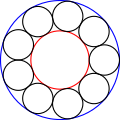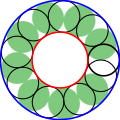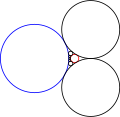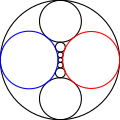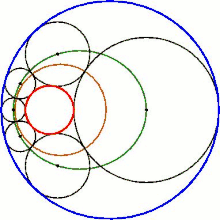Steiner chain
A Steiner chain (also Steiner circle chain ) is in geometry a connected sequence of finitely many, touching circles, each of which also touches two predetermined, non-intersecting circles - hereinafter referred to as “starting circles”.
The Steiner chain is named after the Swiss mathematician Jakob Steiner , who defined it in the 19th century and who discovered and described many of its properties.
variants
For the following considerations, it is helpful to imagine the successive structure of a Steiner chain, starting with a "starting circle" and ending with an "ending circle". In the closed Steiner chain that is usually considered , the end circle also touches the start circle again; in an open chain this is not the case. The only condition for the output circles is that they do not touch or intersect each other. This means that either a smaller circle lies entirely within a larger one, or that the two circles lie outside of each other without touching each other.
The figure shows the case of a closed Steiner chain with output circles lying one inside the other - hereinafter referred to as the “standard case”.
In addition to the standard case, a number of variants are possible.
Closed, open and multi-cyclical
Usually the closed Steiner chain is considered, in which the end circle touches the start circle again. If this is not the case, there remains a gap ( open Steiner chain) between the start and end circle; if this is closed, the first and last circles overlap. If one can continue such a chain in further "rounds" between the starting circles, so that finally a connection to the first link of the chain takes place, one speaks of a multi-cyclic chain. The figure on the far right shows a Steiner chain, which after a first round (transition from the black lined circles to the green filled ones) rotates a second and then closes.
- Closed, open and multi-cyclic Steiner chain
For the sake of simplicity, the images above show the special case of a Steiner chain in a circular ring .
Variants of circle touch
Not only can the two output circles be inside or outside of each other ("next to each other"), the circles in the chain do not necessarily all have to touch each other externally . This leads to the following variants with regard to the contact of the circles involved (the circles of the chain are shown in black, the output circles in blue and red):
- Variants of circle touch
- The output circles are inside each other , the circles of the chain touch each other as well as the inner output circle externally , the outer one internally . This is the standard case.
- The output circles are next to each other (blue and larger on the left, red and small about in the middle), the circles of the chain touch each other and both output circles externally .
- The output circles are next to each other , seven circles of the - in the example 8-link - chain touch each other as well as both output circles externally , the eighth (the black one on the outside) is touched internally by the two output circles as well as its two neighbors in the chain .
properties
Circular chain set
A fundamental statement about the Steiner chain is the Steiner circular chain theorem (also Steiner's closing theorem ):
- If at least one closed Steiner chain is possible between two output circles, then an infinite number are also possible, whereby any circle that touches the two output circles can be the starting circle of such a chain.
This means that each of these chains can emerge from the original chain by rotating the original chain along the starting circles. The animation illustrates this fact.
Centers and points of contact
The points of contact of the circles in a Steiner chain are always on a circle (gold in the animation).
The centers of the circles lie on a conic section . In the standard case (the two starting circles are one inside the other) this is an ellipse (green in the animation), the focal points of which are the centers of the two starting circles. Incidentally, this is always the case when circles touch a given circle inside and another given circle outside - except for the Steiner chain, also for the Pappos chain , the three-dimensional Soddy hexlet and the Apollonian circles .
In the other case (the starting circles are outside of each other) the center points lie on a hyperbola .
Generalizations
- Generalizations
A generalization of the Steiner chain could be to allow the two starting circles to touch or intersect one another. In the first case you get a Pappos chain with an infinite number of chain links.
The Soddy Hexlet (see animation) is a 6-link Steiner chain extended into the third dimension - the starting circles and the circles of the chain become spheres . The centers of the six balls of the chain (these form the hexlet ) lie on the same ellipse as the centers of the circles of the corresponding Steiner chain. The envelope of the spheres is a Dupin's cyclide , the inversion of a torus . The six spheres of the hexlet not only touch the inner (colored red) and the outer "starting sphere", but also two other spheres (not shown in the animation) that are above or below the level of the hexlet center points.
See also
Web links
- Eric W. Weisstein : Steiner chain . In: MathWorld (English).
- Alexander Bogomolny: Steiner's Chain: What is it? (interactive Java applet)
- Michael Borcherds: Steiner's Chain (interactive Java applet)
- Eric W. Weisstein : Steiner's Porism . In: MathWorld (English).
- Bob Allanson: Steiner's Porism . (interactive Java applet)
Individual evidence
- ↑ Thomas Bauer: The circle chain set by Steiner. Philipps University of Marburg, accessed on April 5, 2012 .
- ^ Bob Allanson: Soddy's Hexlet. Retrieved April 5, 2012 .

